THURSDAY 21 DEC 17
By Jan Wium
Experts have discovered a problematic substance, known as hydrohalite (NaCl, 2H2O), which can be formed on icy salted roads.
Hydrohalite does not react to the usual de-icing method: spreading ordinary road salt. So once hydrohalite has formed, it is not removed by repeated salting.
Hydrohalite is invisible to the naked eye, and it can form on roads, pavements and elsewhere, where it can pose a serious threat if nothing is done about it.
Through conducting various experiments, Associate Professor Rolf W. Berg from DTU Chemistry found out that hydrohalite can easily be detected by means of a Raman spectrometer. This is a relatively small device that can identify the presence of a molecular substance, and as ice and hydrohalite are structurally very different, it is not hard for the instrument to distinguish between the two.
Small and lightweight Raman instruments with lasers can be installed on the winter service vehicles which are used to salt the roads and clear snow. The driver or an automated system can then select the most appropriate method for getting the ice or the slippery hydrohalite to melt.
If hydrohalite is identified, the operator can switch to another and more appropriate way of dealing with the slippery road. Standard road salt is completely ineffective against hydrohalite. Instead, it’s necessary to use sand, for example, to make the highway safe for road users.
The method has been presented by Rolf W. Berg in an article in the scientific journal Applied Spectroscopy Reviews. He says:
“As the nights turn colder, we will once again see ordinary salt being spread extensively to de-ice and anti-ice the roads. However, this method will not work where hydrohalite has formed, exposing the public to an unnecessarily high risk of road accidents.”
“Gritting vehicles can, once the new technology has been fully developed, be fitted with Raman detectors in small boxes which can sit below the trucks. This is a relatively straightforward solution, and it can potentially reduce the number of traffic accidents and even save lives.”
Read the article ‘Raman detection of hydrohalite formation: Avoiding accidents on icy roads by de-icing where salt will not work’ in Applied Spectroscopy Reviews”:












